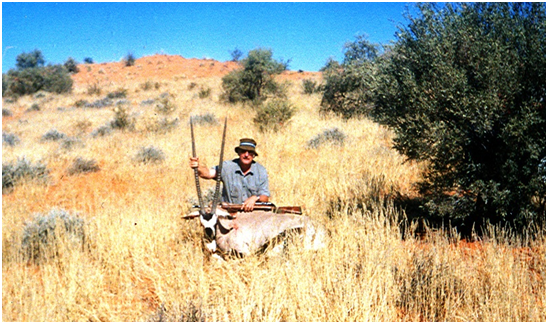Sidebar
The Duiker And The Mauser.
During the early sixties my father had a farm in the Eastern Lowveld. He ran some stock but for a cash crop he planted tobacco, maize and tomatoes. The Lowveld is frost free and therefore imminently suitable for raising market produce at a time when the rest of the land is locked in the cold of winter. This, however, was the cause of our troubles because it meant that at a time when the rest of the veldt was dry and dusty, my father’s tomato crop was the main source of attraction for all the kudu, impala and sundry herbivores in our immediate vicinity. Nature Conservation Officials were sympathetic and issued a night hunting permit, which at the time meant the use of an old-fashioned “bulala light” that worked off torch batteries.
Kudu and impala soon got the message but not so the duiker and steenbuck. There was a particular duiker that was causing a lot of damage. Row upon row he would systematically nip off the new growth from the tomato plants. Have you ever tried to hunt a skelm1) duiker2)? The moment you pick up his eyes in the light, he will calmly turn his back on you, skip to the next row of tomatoes and continue feeding. If you harass him too much, he will seek cover in the nearest patch of undergrowth and be back the following night. This one was wise to all the tricks we tried so it was obvious that we would have to think up a new one.
One night at the dark of the moon, my dad and I tied up the dogs and armed with a .22 rim fire and 12-bore shotgun, we set out to destroy the crop raider. In the pitch-black darkness we circled around to cut him off from his escape route. The idea was to get as close as possible to his normal feeding spot without being detected, switch on the light and let him have it with the .22. I would be backup with the old Stevens 12 bore in case my dad missed and the duiker tried to escape past us to his favourite lying-up place. I must digress for a moment. In clearing the land for plowing, we had dragged all the large tree stumps to the edge of the field, thereby forming a natural fence to keep out domestic stock. It was over this rough barrier that we had to approach.
My father motioned me to wait while he quietly climbed over, aided by the light of the hunting torch. In the act of stepping down, he lifted his head and shone the beam into the eyes of the duiker where it was hidden by the lush growth of the tomatoes not twenty yards away. I can still see him cock, aim and fire the old BSA. At the crack of the shot I heard the distinctive “thwack” of a bullet finding its mark and my father’s satisfied “Got him!” We approached the downed duiker with the light shining down so that we could see where to place our feet to avoid damaging the tomato plants. My father’s shout of “Watch out!” and the arc of the light as he leaped aside happened simultaneously, leaving me rooted to the spot in the blackness of the night, tightly clutching the old shotgun. What seemed like hours later, the light came on and we found ourselves staring into the blazing eyes of a leopard, crouched and seemingly ready to attack. A trickle of blood ran from the tiny hole between his eyes to the tip of his nose.
We were pretty chuffed with ourselves and showed the skin to all and sundry until one day a man came along who wanted to trade it for an old and worn out 8x57JS Mauser. It had seen some hard use and the barrel was worn but it was a Mauser and had the Crown and Eagle-emblem with the words “SPANDAU.1900” stamped on the action. The drought came, the farm was sold and my folks moved to the city taking the old rifle with them. For many years I pestered my father for the rifle but no, I couldn’t have it.
By then I had a good battery of guns of my own and he decided that I didn’t need one more. The old Stevens would go to my second brother, the BSA .22 to the third and the Mauser to the youngest. Granted, I had practically everything from a .22 to a 375 H&H but for some time had felt the need for something that would push 180 grains at 3000 f.p.s. from dune to dune in the Kalahari . All things come to those who wait so when the youngster found himself in a bind we bargained, some money changed hands and the old Mauser was mine. I took the action to a gunsmith and had my 300 Win Mag3) built. All in matt finish, it has a semi bull barrel and a Timney trigger fitted to a synthetic stock. Topped by an all-steel Weaver ‘scope, it groups within one minute of angle.4)
We became close companions over time, notching up a respectable number of kudu bulls between the two of us. It was, however, built for long distance shooting, so in time that is where we went - to the red dunes of the Kalahari to hunt for the illusive unicorn of the desert – the gemsbuck. The ghost of the leopard went with us…


